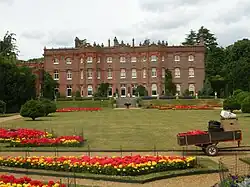Edward Buckton Lamb (1806–1869) was a British architect who exhibited at the Royal Academy from 1824. Lamb was labelled a 'Rogue Gothic Revivalist', and his designs were roundly criticised for breaking with convention, especially by The Ecclesiologist.[1] More recently Nikolaus Pevsner called him "the most original though certainly not the most accomplished architect of his day".[2]
Life

He was born in London, England, his father James Lamb being a government official. He was articled to Lewis Nockalls Cottingham.[3]
He was selected to design the chapel for the Brompton Hospital, then being built to the designs of Frederick John Francis, and was retained to complete the main building, in collaboration with Francis.[4]
He contributed to Loudon's Encyclopaedia (1833), published studies on Gothic Ornament (1830), Ancient Domestic Architecture (1846) with text by William Henry Leeds, and contributed regularly to the Architectural Magazine (1834–8).
He died in the summer of 1869 and was buried on the western side of Highgate Cemetery.
Buildings
Notable buildings he was responsible for include:
- Brompton Hospital Chapel, London, and in collaboration with F.J. Francis, parts of the main Hospital building.
- All Saints' Church, Hartlepool
- St Stephen's Church, Aldwark, Yorkshire (1846–53)[2]
- St Luke's Chapel, Brompton Hospital (1849)
- St Margaret's, Leiston, Suffolk (1853)
- Christ Church, Hartlepool (1854)
- Berkhamsted Town Hall
- Episcopal Church, Dumfries
- Eye Town Hall
- Hrádek u Nechanic
- Disraeli Monument, Hughenden, Buckinghamshire (1862).[5]
- St Martin's Church, Gospel Oak, London (consecrated 1865)[6]
- St Mary Magdalene Church, Addiscombe (1868–70)
- Hughenden Manor, alterations for Benjamin Disraeli
- Wadhurst Castle
- St. Ninian's Episcopal Church, Castle Douglas, Scotland
- Carnsalloch Chapel at The Mount, Kirkton, Dumfries
Gallery
 Berkhamsted Town Hall by Lamb.
Berkhamsted Town Hall by Lamb. Christ Church, Hartlepool, designed by Lamb in 1854, now Hartlepool Art Gallery.
Christ Church, Hartlepool, designed by Lamb in 1854, now Hartlepool Art Gallery. Hughenden Manor as redesigned by Lamb in 1862.
Hughenden Manor as redesigned by Lamb in 1862. Lamb's son, Edward Beckitt Lamb, was also an architect. He and John Pollard Seddon created this 1904 design for a new Imperial Monumental Halls and Tower at Westminster was supposed to house the monuments alongside imperial trophies. The Gothic Revival tower would have been the tallest building in the UK with a similar floor area to the Abbey next door. Several different drawings from different angles were created.
Lamb's son, Edward Beckitt Lamb, was also an architect. He and John Pollard Seddon created this 1904 design for a new Imperial Monumental Halls and Tower at Westminster was supposed to house the monuments alongside imperial trophies. The Gothic Revival tower would have been the tallest building in the UK with a similar floor area to the Abbey next door. Several different drawings from different angles were created.
Publications
- Etchings of Gothic Ornament 1830
- Lamb, Edward Buckton (1846). Studies of Ancient Domestic Architecture. John Weale. Retrieved 9 May 2019.
References
- . Dictionary of National Biography. London: Smith, Elder & Co. 1885–1900.
Notes
- ↑ The Ecclesiologist. Ecclesiological society. 1855. p. 150.
- 1 2 Pevsner, Nikolaus (1981). Yorkshire: The North Riding. The Buildings of England. Yale University Press. ISBN 9780300096651.
- ↑ Edward Buckton Lamb, DSA Architect Biography Report, UK.
- ↑ F. H. W. Sheppard (General Editor) (1983). "The Brompton Hospital Estate". Survey of London: volume 41: Brompton. Institute of Historical Research. Retrieved 5 May 2012.
{{cite web}}:|author=has generic name (help) - ↑ Benjamin Disraeli; Melvin George Wiebe (2009). Benjamin Disraeli Letters: 1860-1864. University of Toronto Press. p. 203. ISBN 978-0-8020-9949-5.
- ↑ Walter H. Godfrey and W. McB. Marcham (editors) (1952). "Additional Churches". Survey of London: volume 24: The parish of St Pancras part 4: King’s Cross Neighbourhood. Institute of Historical Research. Retrieved 5 May 2012.
{{cite web}}:|author=has generic name (help)
External links
- "Lamb, Edward Buckton". Oxford Dictionary of National Biography (online ed.). Oxford University Press. doi:10.1093/ref:odnb/15913. (Subscription or UK public library membership required.). The first edition of this text is available at Wikisource: . Dictionary of National Biography. London: Smith, Elder & Co. 1885–1900.